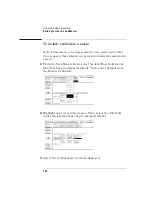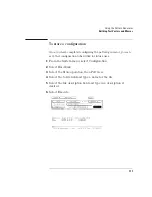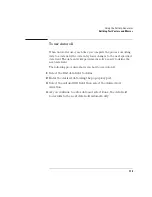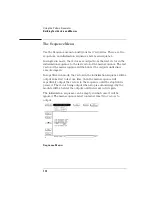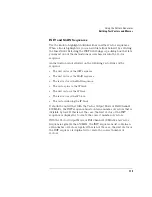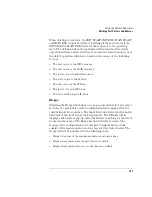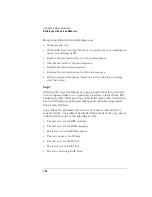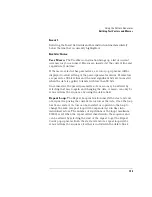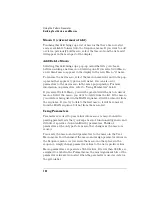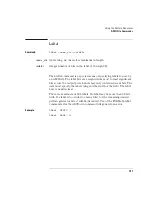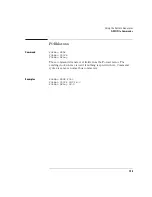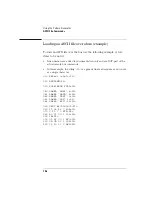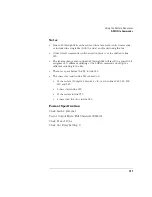
184
Using the Pattern Generator
Building Test Vectors and Macros
Break.
The Break instruction causes a break at the current vector. In
single run mode, this instruction halts the sequence and holds the
outputs at the break vector’s value. In repetitive run mode, this
instruction pauses the sequence at the current vector momentarily,
then continues.
NOTE:
When operating at 200 MHz you can not have 2 Break events in succession.
This also includes the Wait event.
Signal IMB.
The Signal IMB instruction creates a signal for the IMB
bus of the HP 1660EP-series at the current vector, allowing the pattern
generator to trigger the state or timing analyzers. Multiple signal IMB
instructions may be placed in the sequence, but only the first signal
IMB will be executed.
Wait Event.
The Wait Event instruction halts the execution of the
program sequence until the event is received by the hardware.
Selecting this instruction brings up a pop-up menu that lets you set
four data patterns and select one of them or an IMB signal as the event
the pattern generator is waiting for.
An external wait event is the ORing of the three input lines on the clock
pod. The first wait IMB is the only one recognized because IMB does
not allow pulsing.
NOTE:
When operating at 200 MHz you can not have 2 Wait events in succession. This
also includes the Break event.
If Event.
The If Event instruction is only available in Full Channel 100
Mbit/s mode with clock frequencies of 50 MHz and lower. Only one If
Event is allowed in a sequence program. If a new if instruction is placed
in a program sequence, a message will appear stating that only one if
instruction is allowed. To add a new if instruction, the old one must be
deleted.
Summary of Contents for 1670E Series
Page 6: ...6 In This Book...
Page 26: ...26 Contents...
Page 27: ...27 Section 1 Logic Analyzer...
Page 28: ...28...
Page 29: ...29 1 Logic Analyzer Overview...
Page 39: ...39 2 Connecting Peripherals...
Page 49: ...49 3 Using the Logic Analyzer...
Page 72: ...72 Using the Logic Analyzer The Inverse Assembler...
Page 73: ...73 4 Using the Trigger Menu...
Page 101: ...101 5 Using the Oscilloscope...
Page 151: ...151 6 Using the Pattern Generator...
Page 199: ...199 7 Triggering Examples...
Page 237: ...237 8 File Management...
Page 249: ...249 9 Logic Analyzer Reference...
Page 360: ...360 Logic Analyzer Reference The Compare Menu...
Page 361: ...361 10 System Performance Analysis SPA Software...
Page 397: ...397 11 Logic Analyzer Concepts...
Page 430: ...430 Logic Analyzer Concepts The Analyzer Hardware Oscilloscope board theory Oscilloscope board...
Page 439: ...439 12 Troubleshooting the Logic Analyzer...
Page 455: ...455 13 Specifications...
Page 471: ...471 14 Operator s Service...
Page 479: ...479 Operator s Service Troubleshooting Troubleshooting Flowchart 2...
Page 491: ...491 Section 2 LAN...
Page 492: ...492...
Page 493: ...493 15 Introducing the LAN Interface...
Page 497: ...497 16 Connecting and Configuring the LAN...
Page 506: ...506 Connecting and Configuring the LAN Connecting and Configuring the LAN...
Page 507: ...507 17 Accessing the Logic Analyzer File System Using the LAN...
Page 515: ...515 18 Using the LAN s X Window Interface...
Page 527: ...527 19 Retrieving and Restoring Data Using the LAN...
Page 539: ...539 20 Programming the Logic Analyzer Using the LAN...
Page 546: ...546 Programming the Logic Analyzer Using the LAN Programming the Logic Analyzer Using the LAN...
Page 547: ...547 21 LAN Concepts...
Page 555: ...555 22 Troubleshooting the LAN Connection...
Page 580: ...580 Troubleshooting the LAN Connection Getting Service Support...
Page 581: ...581 Section 3 Symbol Utility...
Page 582: ...582...
Page 583: ...583 23 Symbol Utility Introduction...
Page 588: ...588 Symbol Utility Introduction Symbol Utility Introduction...
Page 589: ...589 24 Getting Started with the Symbol Utility...
Page 597: ...597 25 Using the Symbol Utility...
Page 609: ...609 26 Symbol Utility Features and Functions...

